Leadership Management: Analyzing Conflict and Providing Solutions
VerifiedAdded on 2023/06/04
|10
|4805
|462
Report
AI Summary
This report provides a detailed analysis of various conflict situations within a leadership management context and proposes practical solutions. It addresses scenarios involving a sales manager's ethical lapse, a boss's resistance to change, and general conflict resolution approaches. The report delves into concepts such as Kohlberg's theory of moral development, interpersonal orientation, and change management strategies. For the sales manager scenario, the recommendation includes an apology, interpersonal skills improvement, and moral development. To address the boss's resistance to change, the report suggests highlighting the benefits of creativity and innovation, overcoming mental blocks, and using creative analogies to shift perspectives. Finally, the report outlines five conflict resolution approaches: competing, accommodating, avoiding, collaborating, and compromising, emphasizing the importance of choosing the appropriate approach based on the situation. This student assignment is available on Desklib, a platform offering AI-based study tools and a wealth of academic resources.
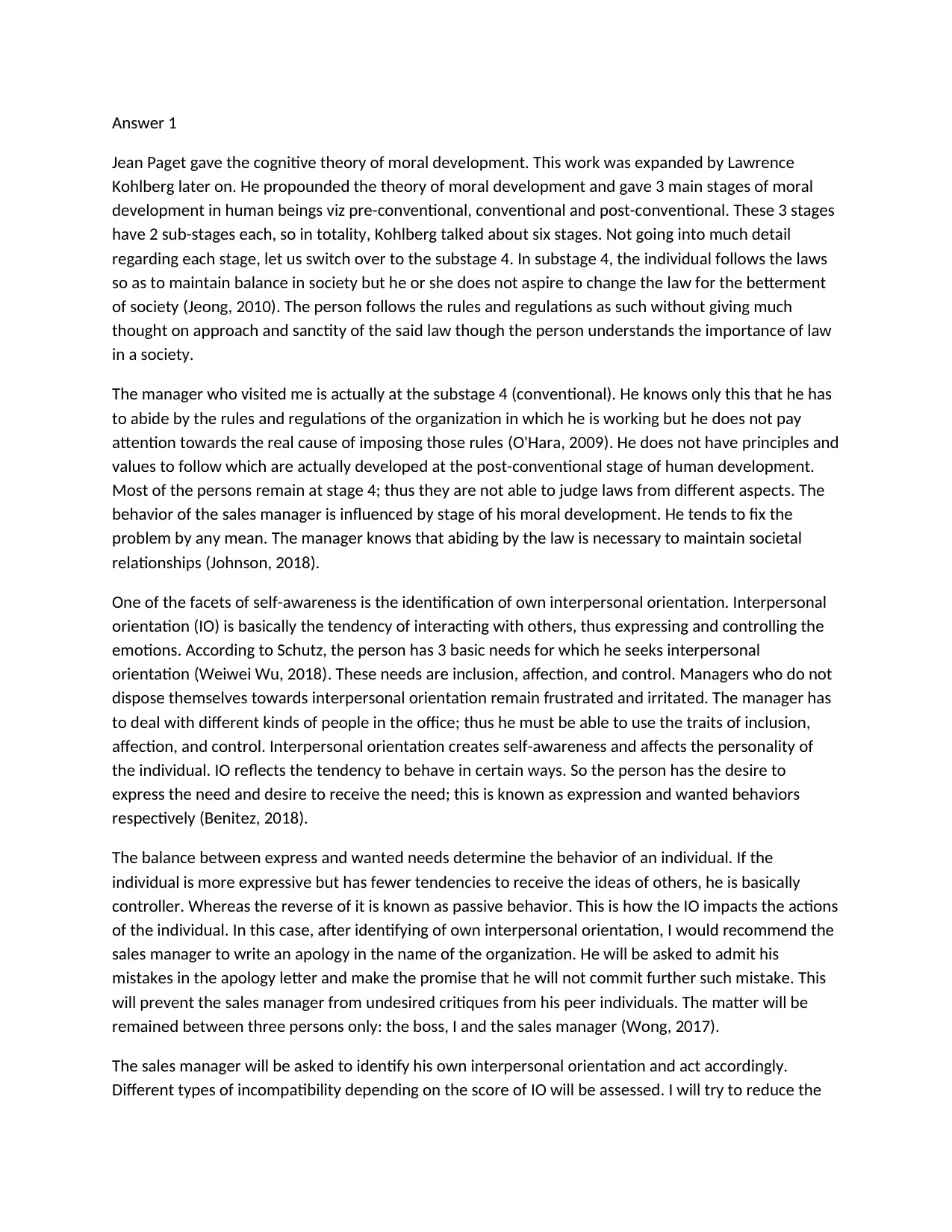
Answer 1
Jean Paget gave the cognitive theory of moral development. This work was expanded by Lawrence
Kohlberg later on. He propounded the theory of moral development and gave 3 main stages of moral
development in human beings viz pre-conventional, conventional and post-conventional. These 3 stages
have 2 sub-stages each, so in totality, Kohlberg talked about six stages. Not going into much detail
regarding each stage, let us switch over to the substage 4. In substage 4, the individual follows the laws
so as to maintain balance in society but he or she does not aspire to change the law for the betterment
of society (Jeong, 2010). The person follows the rules and regulations as such without giving much
thought on approach and sanctity of the said law though the person understands the importance of law
in a society.
The manager who visited me is actually at the substage 4 (conventional). He knows only this that he has
to abide by the rules and regulations of the organization in which he is working but he does not pay
attention towards the real cause of imposing those rules (O'Hara, 2009). He does not have principles and
values to follow which are actually developed at the post-conventional stage of human development.
Most of the persons remain at stage 4; thus they are not able to judge laws from different aspects. The
behavior of the sales manager is influenced by stage of his moral development. He tends to fix the
problem by any mean. The manager knows that abiding by the law is necessary to maintain societal
relationships (Johnson, 2018).
One of the facets of self-awareness is the identification of own interpersonal orientation. Interpersonal
orientation (IO) is basically the tendency of interacting with others, thus expressing and controlling the
emotions. According to Schutz, the person has 3 basic needs for which he seeks interpersonal
orientation (Weiwei Wu, 2018). These needs are inclusion, affection, and control. Managers who do not
dispose themselves towards interpersonal orientation remain frustrated and irritated. The manager has
to deal with different kinds of people in the office; thus he must be able to use the traits of inclusion,
affection, and control. Interpersonal orientation creates self-awareness and affects the personality of
the individual. IO reflects the tendency to behave in certain ways. So the person has the desire to
express the need and desire to receive the need; this is known as expression and wanted behaviors
respectively (Benitez, 2018).
The balance between express and wanted needs determine the behavior of an individual. If the
individual is more expressive but has fewer tendencies to receive the ideas of others, he is basically
controller. Whereas the reverse of it is known as passive behavior. This is how the IO impacts the actions
of the individual. In this case, after identifying of own interpersonal orientation, I would recommend the
sales manager to write an apology in the name of the organization. He will be asked to admit his
mistakes in the apology letter and make the promise that he will not commit further such mistake. This
will prevent the sales manager from undesired critiques from his peer individuals. The matter will be
remained between three persons only: the boss, I and the sales manager (Wong, 2017).
The sales manager will be asked to identify his own interpersonal orientation and act accordingly.
Different types of incompatibility depending on the score of IO will be assessed. I will try to reduce the
Jean Paget gave the cognitive theory of moral development. This work was expanded by Lawrence
Kohlberg later on. He propounded the theory of moral development and gave 3 main stages of moral
development in human beings viz pre-conventional, conventional and post-conventional. These 3 stages
have 2 sub-stages each, so in totality, Kohlberg talked about six stages. Not going into much detail
regarding each stage, let us switch over to the substage 4. In substage 4, the individual follows the laws
so as to maintain balance in society but he or she does not aspire to change the law for the betterment
of society (Jeong, 2010). The person follows the rules and regulations as such without giving much
thought on approach and sanctity of the said law though the person understands the importance of law
in a society.
The manager who visited me is actually at the substage 4 (conventional). He knows only this that he has
to abide by the rules and regulations of the organization in which he is working but he does not pay
attention towards the real cause of imposing those rules (O'Hara, 2009). He does not have principles and
values to follow which are actually developed at the post-conventional stage of human development.
Most of the persons remain at stage 4; thus they are not able to judge laws from different aspects. The
behavior of the sales manager is influenced by stage of his moral development. He tends to fix the
problem by any mean. The manager knows that abiding by the law is necessary to maintain societal
relationships (Johnson, 2018).
One of the facets of self-awareness is the identification of own interpersonal orientation. Interpersonal
orientation (IO) is basically the tendency of interacting with others, thus expressing and controlling the
emotions. According to Schutz, the person has 3 basic needs for which he seeks interpersonal
orientation (Weiwei Wu, 2018). These needs are inclusion, affection, and control. Managers who do not
dispose themselves towards interpersonal orientation remain frustrated and irritated. The manager has
to deal with different kinds of people in the office; thus he must be able to use the traits of inclusion,
affection, and control. Interpersonal orientation creates self-awareness and affects the personality of
the individual. IO reflects the tendency to behave in certain ways. So the person has the desire to
express the need and desire to receive the need; this is known as expression and wanted behaviors
respectively (Benitez, 2018).
The balance between express and wanted needs determine the behavior of an individual. If the
individual is more expressive but has fewer tendencies to receive the ideas of others, he is basically
controller. Whereas the reverse of it is known as passive behavior. This is how the IO impacts the actions
of the individual. In this case, after identifying of own interpersonal orientation, I would recommend the
sales manager to write an apology in the name of the organization. He will be asked to admit his
mistakes in the apology letter and make the promise that he will not commit further such mistake. This
will prevent the sales manager from undesired critiques from his peer individuals. The matter will be
remained between three persons only: the boss, I and the sales manager (Wong, 2017).
The sales manager will be asked to identify his own interpersonal orientation and act accordingly.
Different types of incompatibility depending on the score of IO will be assessed. I will try to reduce the
Paraphrase This Document
Need a fresh take? Get an instant paraphrase of this document with our AI Paraphraser
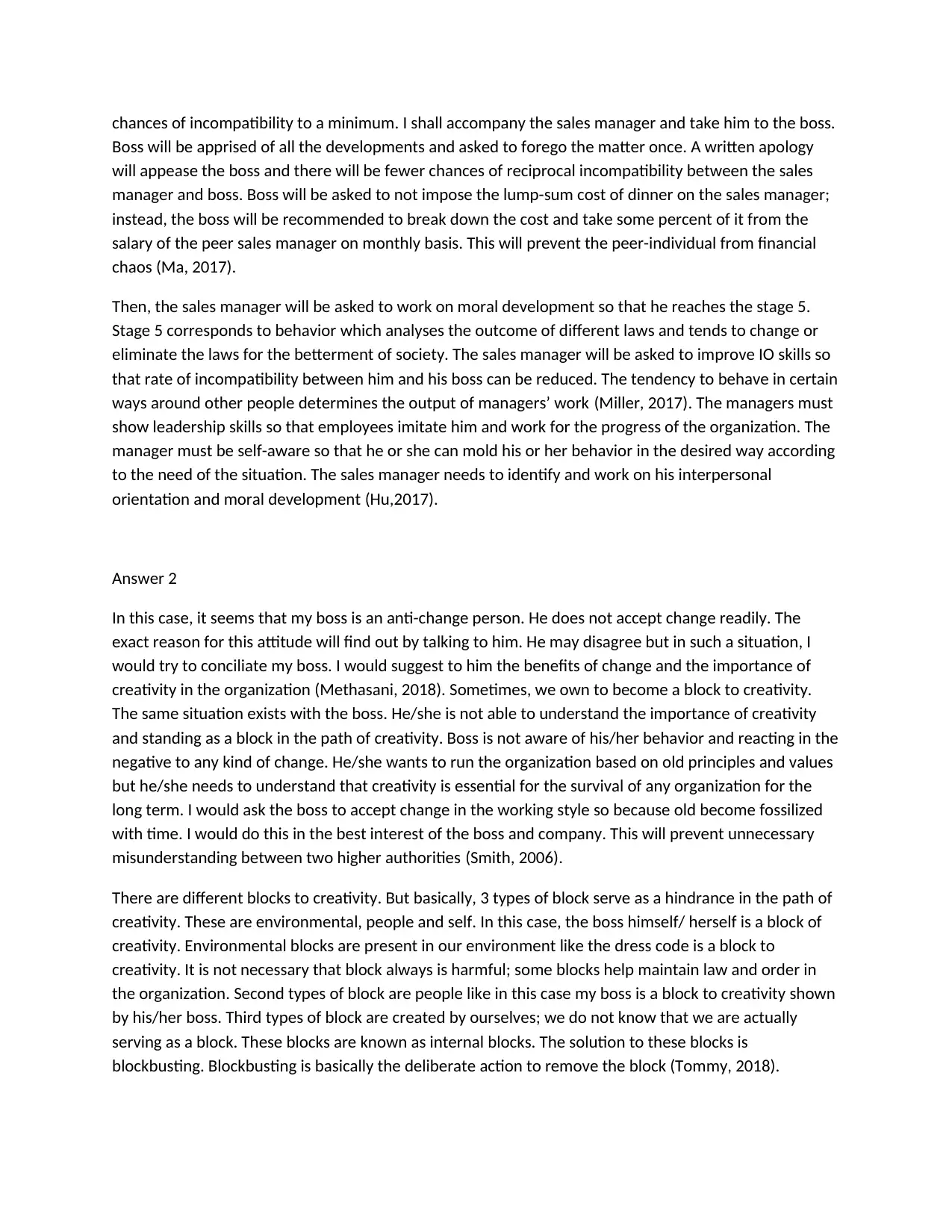
chances of incompatibility to a minimum. I shall accompany the sales manager and take him to the boss.
Boss will be apprised of all the developments and asked to forego the matter once. A written apology
will appease the boss and there will be fewer chances of reciprocal incompatibility between the sales
manager and boss. Boss will be asked to not impose the lump-sum cost of dinner on the sales manager;
instead, the boss will be recommended to break down the cost and take some percent of it from the
salary of the peer sales manager on monthly basis. This will prevent the peer-individual from financial
chaos (Ma, 2017).
Then, the sales manager will be asked to work on moral development so that he reaches the stage 5.
Stage 5 corresponds to behavior which analyses the outcome of different laws and tends to change or
eliminate the laws for the betterment of society. The sales manager will be asked to improve IO skills so
that rate of incompatibility between him and his boss can be reduced. The tendency to behave in certain
ways around other people determines the output of managers’ work (Miller, 2017). The managers must
show leadership skills so that employees imitate him and work for the progress of the organization. The
manager must be self-aware so that he or she can mold his or her behavior in the desired way according
to the need of the situation. The sales manager needs to identify and work on his interpersonal
orientation and moral development (Hu,2017).
Answer 2
In this case, it seems that my boss is an anti-change person. He does not accept change readily. The
exact reason for this attitude will find out by talking to him. He may disagree but in such a situation, I
would try to conciliate my boss. I would suggest to him the benefits of change and the importance of
creativity in the organization (Methasani, 2018). Sometimes, we own to become a block to creativity.
The same situation exists with the boss. He/she is not able to understand the importance of creativity
and standing as a block in the path of creativity. Boss is not aware of his/her behavior and reacting in the
negative to any kind of change. He/she wants to run the organization based on old principles and values
but he/she needs to understand that creativity is essential for the survival of any organization for the
long term. I would ask the boss to accept change in the working style so because old become fossilized
with time. I would do this in the best interest of the boss and company. This will prevent unnecessary
misunderstanding between two higher authorities (Smith, 2006).
There are different blocks to creativity. But basically, 3 types of block serve as a hindrance in the path of
creativity. These are environmental, people and self. In this case, the boss himself/ herself is a block of
creativity. Environmental blocks are present in our environment like the dress code is a block to
creativity. It is not necessary that block always is harmful; some blocks help maintain law and order in
the organization. Second types of block are people like in this case my boss is a block to creativity shown
by his/her boss. Third types of block are created by ourselves; we do not know that we are actually
serving as a block. These blocks are known as internal blocks. The solution to these blocks is
blockbusting. Blockbusting is basically the deliberate action to remove the block (Tommy, 2018).
Boss will be apprised of all the developments and asked to forego the matter once. A written apology
will appease the boss and there will be fewer chances of reciprocal incompatibility between the sales
manager and boss. Boss will be asked to not impose the lump-sum cost of dinner on the sales manager;
instead, the boss will be recommended to break down the cost and take some percent of it from the
salary of the peer sales manager on monthly basis. This will prevent the peer-individual from financial
chaos (Ma, 2017).
Then, the sales manager will be asked to work on moral development so that he reaches the stage 5.
Stage 5 corresponds to behavior which analyses the outcome of different laws and tends to change or
eliminate the laws for the betterment of society. The sales manager will be asked to improve IO skills so
that rate of incompatibility between him and his boss can be reduced. The tendency to behave in certain
ways around other people determines the output of managers’ work (Miller, 2017). The managers must
show leadership skills so that employees imitate him and work for the progress of the organization. The
manager must be self-aware so that he or she can mold his or her behavior in the desired way according
to the need of the situation. The sales manager needs to identify and work on his interpersonal
orientation and moral development (Hu,2017).
Answer 2
In this case, it seems that my boss is an anti-change person. He does not accept change readily. The
exact reason for this attitude will find out by talking to him. He may disagree but in such a situation, I
would try to conciliate my boss. I would suggest to him the benefits of change and the importance of
creativity in the organization (Methasani, 2018). Sometimes, we own to become a block to creativity.
The same situation exists with the boss. He/she is not able to understand the importance of creativity
and standing as a block in the path of creativity. Boss is not aware of his/her behavior and reacting in the
negative to any kind of change. He/she wants to run the organization based on old principles and values
but he/she needs to understand that creativity is essential for the survival of any organization for the
long term. I would ask the boss to accept change in the working style so because old become fossilized
with time. I would do this in the best interest of the boss and company. This will prevent unnecessary
misunderstanding between two higher authorities (Smith, 2006).
There are different blocks to creativity. But basically, 3 types of block serve as a hindrance in the path of
creativity. These are environmental, people and self. In this case, the boss himself/ herself is a block of
creativity. Environmental blocks are present in our environment like the dress code is a block to
creativity. It is not necessary that block always is harmful; some blocks help maintain law and order in
the organization. Second types of block are people like in this case my boss is a block to creativity shown
by his/her boss. Third types of block are created by ourselves; we do not know that we are actually
serving as a block. These blocks are known as internal blocks. The solution to these blocks is
blockbusting. Blockbusting is basically the deliberate action to remove the block (Tommy, 2018).
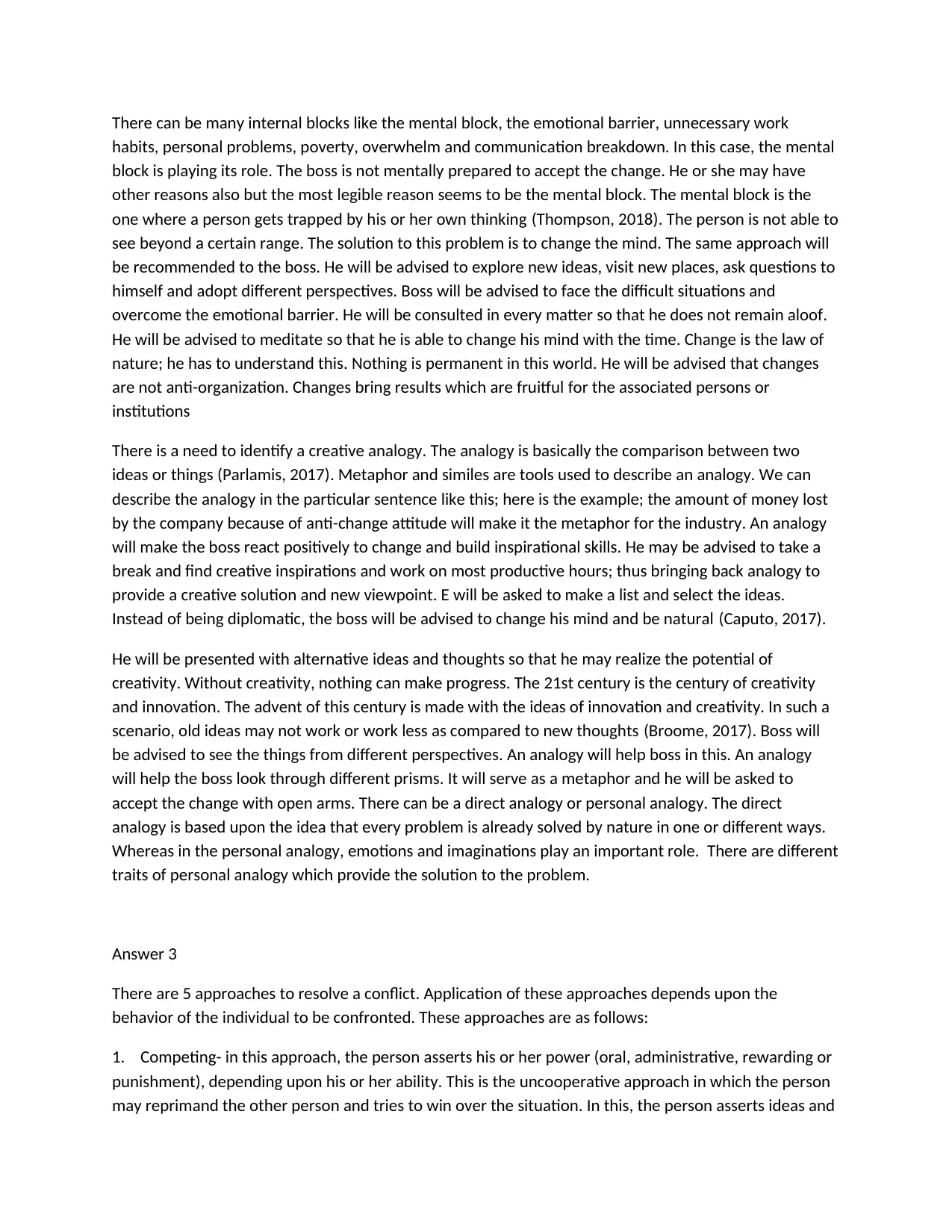
There can be many internal blocks like the mental block, the emotional barrier, unnecessary work
habits, personal problems, poverty, overwhelm and communication breakdown. In this case, the mental
block is playing its role. The boss is not mentally prepared to accept the change. He or she may have
other reasons also but the most legible reason seems to be the mental block. The mental block is the
one where a person gets trapped by his or her own thinking (Thompson, 2018). The person is not able to
see beyond a certain range. The solution to this problem is to change the mind. The same approach will
be recommended to the boss. He will be advised to explore new ideas, visit new places, ask questions to
himself and adopt different perspectives. Boss will be advised to face the difficult situations and
overcome the emotional barrier. He will be consulted in every matter so that he does not remain aloof.
He will be advised to meditate so that he is able to change his mind with the time. Change is the law of
nature; he has to understand this. Nothing is permanent in this world. He will be advised that changes
are not anti-organization. Changes bring results which are fruitful for the associated persons or
institutions
There is a need to identify a creative analogy. The analogy is basically the comparison between two
ideas or things (Parlamis, 2017). Metaphor and similes are tools used to describe an analogy. We can
describe the analogy in the particular sentence like this; here is the example; the amount of money lost
by the company because of anti-change attitude will make it the metaphor for the industry. An analogy
will make the boss react positively to change and build inspirational skills. He may be advised to take a
break and find creative inspirations and work on most productive hours; thus bringing back analogy to
provide a creative solution and new viewpoint. E will be asked to make a list and select the ideas.
Instead of being diplomatic, the boss will be advised to change his mind and be natural (Caputo, 2017).
He will be presented with alternative ideas and thoughts so that he may realize the potential of
creativity. Without creativity, nothing can make progress. The 21st century is the century of creativity
and innovation. The advent of this century is made with the ideas of innovation and creativity. In such a
scenario, old ideas may not work or work less as compared to new thoughts (Broome, 2017). Boss will
be advised to see the things from different perspectives. An analogy will help boss in this. An analogy
will help the boss look through different prisms. It will serve as a metaphor and he will be asked to
accept the change with open arms. There can be a direct analogy or personal analogy. The direct
analogy is based upon the idea that every problem is already solved by nature in one or different ways.
Whereas in the personal analogy, emotions and imaginations play an important role. There are different
traits of personal analogy which provide the solution to the problem.
Answer 3
There are 5 approaches to resolve a conflict. Application of these approaches depends upon the
behavior of the individual to be confronted. These approaches are as follows:
1. Competing- in this approach, the person asserts his or her power (oral, administrative, rewarding or
punishment), depending upon his or her ability. This is the uncooperative approach in which the person
may reprimand the other person and tries to win over the situation. In this, the person asserts ideas and
habits, personal problems, poverty, overwhelm and communication breakdown. In this case, the mental
block is playing its role. The boss is not mentally prepared to accept the change. He or she may have
other reasons also but the most legible reason seems to be the mental block. The mental block is the
one where a person gets trapped by his or her own thinking (Thompson, 2018). The person is not able to
see beyond a certain range. The solution to this problem is to change the mind. The same approach will
be recommended to the boss. He will be advised to explore new ideas, visit new places, ask questions to
himself and adopt different perspectives. Boss will be advised to face the difficult situations and
overcome the emotional barrier. He will be consulted in every matter so that he does not remain aloof.
He will be advised to meditate so that he is able to change his mind with the time. Change is the law of
nature; he has to understand this. Nothing is permanent in this world. He will be advised that changes
are not anti-organization. Changes bring results which are fruitful for the associated persons or
institutions
There is a need to identify a creative analogy. The analogy is basically the comparison between two
ideas or things (Parlamis, 2017). Metaphor and similes are tools used to describe an analogy. We can
describe the analogy in the particular sentence like this; here is the example; the amount of money lost
by the company because of anti-change attitude will make it the metaphor for the industry. An analogy
will make the boss react positively to change and build inspirational skills. He may be advised to take a
break and find creative inspirations and work on most productive hours; thus bringing back analogy to
provide a creative solution and new viewpoint. E will be asked to make a list and select the ideas.
Instead of being diplomatic, the boss will be advised to change his mind and be natural (Caputo, 2017).
He will be presented with alternative ideas and thoughts so that he may realize the potential of
creativity. Without creativity, nothing can make progress. The 21st century is the century of creativity
and innovation. The advent of this century is made with the ideas of innovation and creativity. In such a
scenario, old ideas may not work or work less as compared to new thoughts (Broome, 2017). Boss will
be advised to see the things from different perspectives. An analogy will help boss in this. An analogy
will help the boss look through different prisms. It will serve as a metaphor and he will be asked to
accept the change with open arms. There can be a direct analogy or personal analogy. The direct
analogy is based upon the idea that every problem is already solved by nature in one or different ways.
Whereas in the personal analogy, emotions and imaginations play an important role. There are different
traits of personal analogy which provide the solution to the problem.
Answer 3
There are 5 approaches to resolve a conflict. Application of these approaches depends upon the
behavior of the individual to be confronted. These approaches are as follows:
1. Competing- in this approach, the person asserts his or her power (oral, administrative, rewarding or
punishment), depending upon his or her ability. This is the uncooperative approach in which the person
may reprimand the other person and tries to win over the situation. In this, the person asserts ideas and
⊘ This is a preview!⊘
Do you want full access?
Subscribe today to unlock all pages.

Trusted by 1+ million students worldwide
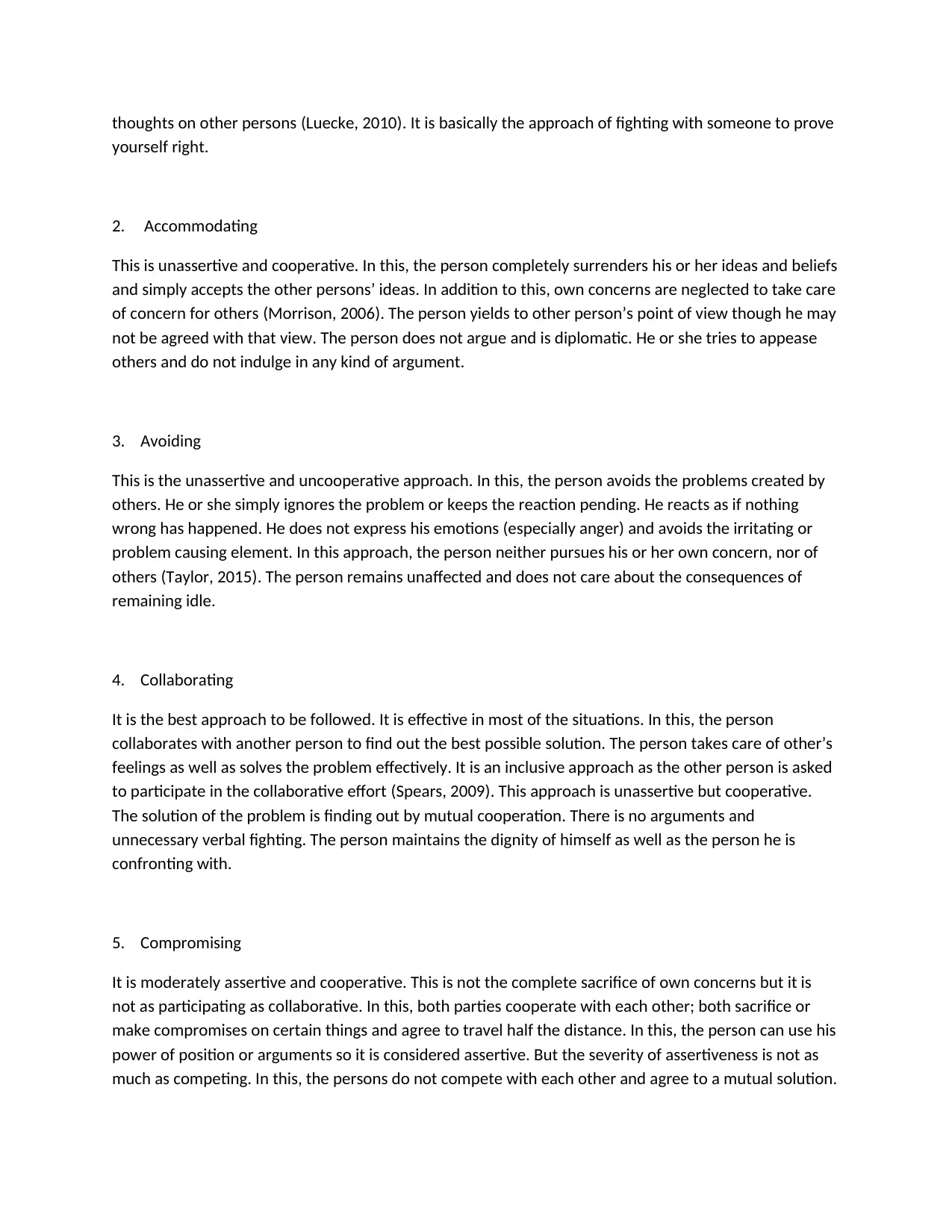
thoughts on other persons (Luecke, 2010). It is basically the approach of fighting with someone to prove
yourself right.
2. Accommodating
This is unassertive and cooperative. In this, the person completely surrenders his or her ideas and beliefs
and simply accepts the other persons’ ideas. In addition to this, own concerns are neglected to take care
of concern for others (Morrison, 2006). The person yields to other person’s point of view though he may
not be agreed with that view. The person does not argue and is diplomatic. He or she tries to appease
others and do not indulge in any kind of argument.
3. Avoiding
This is the unassertive and uncooperative approach. In this, the person avoids the problems created by
others. He or she simply ignores the problem or keeps the reaction pending. He reacts as if nothing
wrong has happened. He does not express his emotions (especially anger) and avoids the irritating or
problem causing element. In this approach, the person neither pursues his or her own concern, nor of
others (Taylor, 2015). The person remains unaffected and does not care about the consequences of
remaining idle.
4. Collaborating
It is the best approach to be followed. It is effective in most of the situations. In this, the person
collaborates with another person to find out the best possible solution. The person takes care of other’s
feelings as well as solves the problem effectively. It is an inclusive approach as the other person is asked
to participate in the collaborative effort (Spears, 2009). This approach is unassertive but cooperative.
The solution of the problem is finding out by mutual cooperation. There is no arguments and
unnecessary verbal fighting. The person maintains the dignity of himself as well as the person he is
confronting with.
5. Compromising
It is moderately assertive and cooperative. This is not the complete sacrifice of own concerns but it is
not as participating as collaborative. In this, both parties cooperate with each other; both sacrifice or
make compromises on certain things and agree to travel half the distance. In this, the person can use his
power of position or arguments so it is considered assertive. But the severity of assertiveness is not as
much as competing. In this, the persons do not compete with each other and agree to a mutual solution.
yourself right.
2. Accommodating
This is unassertive and cooperative. In this, the person completely surrenders his or her ideas and beliefs
and simply accepts the other persons’ ideas. In addition to this, own concerns are neglected to take care
of concern for others (Morrison, 2006). The person yields to other person’s point of view though he may
not be agreed with that view. The person does not argue and is diplomatic. He or she tries to appease
others and do not indulge in any kind of argument.
3. Avoiding
This is the unassertive and uncooperative approach. In this, the person avoids the problems created by
others. He or she simply ignores the problem or keeps the reaction pending. He reacts as if nothing
wrong has happened. He does not express his emotions (especially anger) and avoids the irritating or
problem causing element. In this approach, the person neither pursues his or her own concern, nor of
others (Taylor, 2015). The person remains unaffected and does not care about the consequences of
remaining idle.
4. Collaborating
It is the best approach to be followed. It is effective in most of the situations. In this, the person
collaborates with another person to find out the best possible solution. The person takes care of other’s
feelings as well as solves the problem effectively. It is an inclusive approach as the other person is asked
to participate in the collaborative effort (Spears, 2009). This approach is unassertive but cooperative.
The solution of the problem is finding out by mutual cooperation. There is no arguments and
unnecessary verbal fighting. The person maintains the dignity of himself as well as the person he is
confronting with.
5. Compromising
It is moderately assertive and cooperative. This is not the complete sacrifice of own concerns but it is
not as participating as collaborative. In this, both parties cooperate with each other; both sacrifice or
make compromises on certain things and agree to travel half the distance. In this, the person can use his
power of position or arguments so it is considered assertive. But the severity of assertiveness is not as
much as competing. In this, the persons do not compete with each other and agree to a mutual solution.
Paraphrase This Document
Need a fresh take? Get an instant paraphrase of this document with our AI Paraphraser
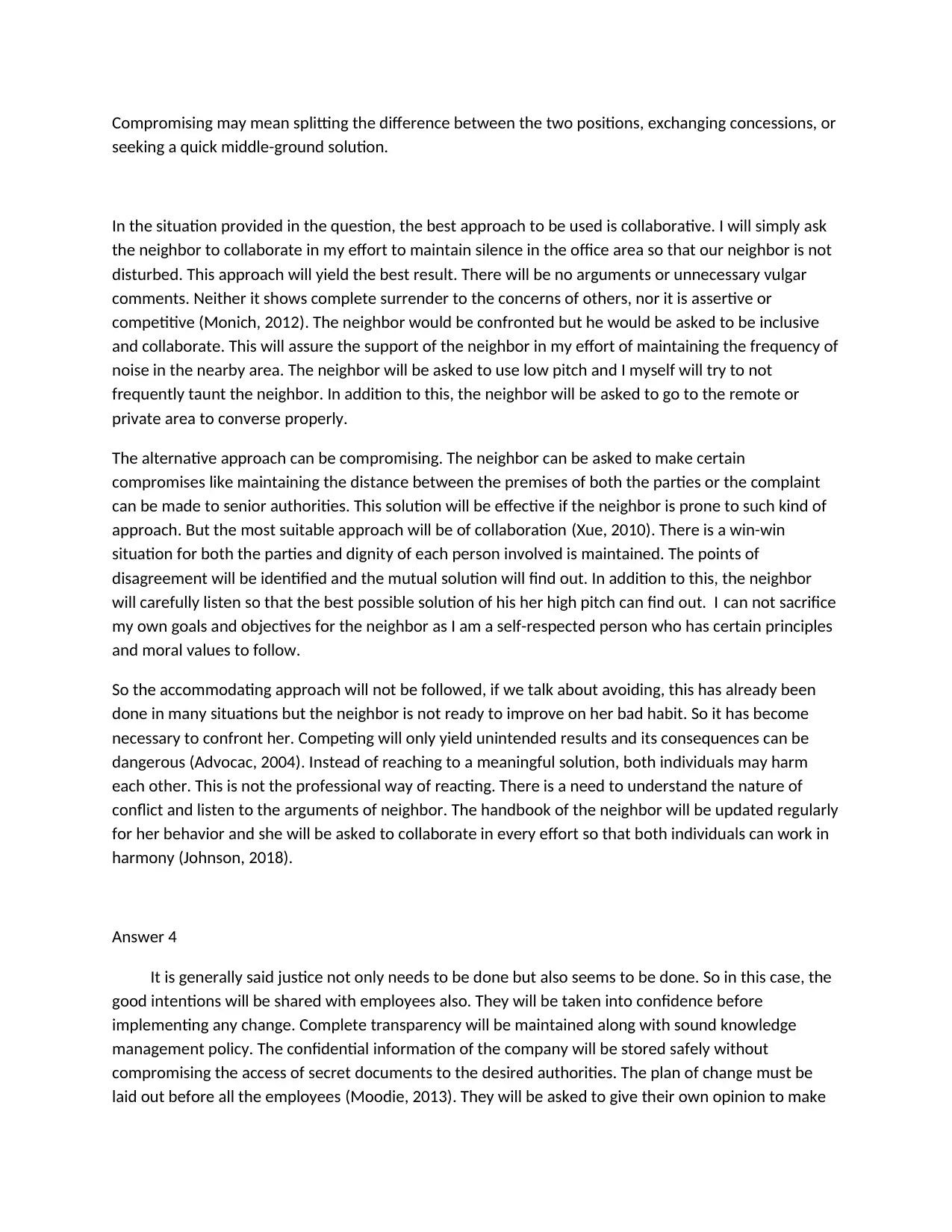
Compromising may mean splitting the difference between the two positions, exchanging concessions, or
seeking a quick middle-ground solution.
In the situation provided in the question, the best approach to be used is collaborative. I will simply ask
the neighbor to collaborate in my effort to maintain silence in the office area so that our neighbor is not
disturbed. This approach will yield the best result. There will be no arguments or unnecessary vulgar
comments. Neither it shows complete surrender to the concerns of others, nor it is assertive or
competitive (Monich, 2012). The neighbor would be confronted but he would be asked to be inclusive
and collaborate. This will assure the support of the neighbor in my effort of maintaining the frequency of
noise in the nearby area. The neighbor will be asked to use low pitch and I myself will try to not
frequently taunt the neighbor. In addition to this, the neighbor will be asked to go to the remote or
private area to converse properly.
The alternative approach can be compromising. The neighbor can be asked to make certain
compromises like maintaining the distance between the premises of both the parties or the complaint
can be made to senior authorities. This solution will be effective if the neighbor is prone to such kind of
approach. But the most suitable approach will be of collaboration (Xue, 2010). There is a win-win
situation for both the parties and dignity of each person involved is maintained. The points of
disagreement will be identified and the mutual solution will find out. In addition to this, the neighbor
will carefully listen so that the best possible solution of his her high pitch can find out. I can not sacrifice
my own goals and objectives for the neighbor as I am a self-respected person who has certain principles
and moral values to follow.
So the accommodating approach will not be followed, if we talk about avoiding, this has already been
done in many situations but the neighbor is not ready to improve on her bad habit. So it has become
necessary to confront her. Competing will only yield unintended results and its consequences can be
dangerous (Advocac, 2004). Instead of reaching to a meaningful solution, both individuals may harm
each other. This is not the professional way of reacting. There is a need to understand the nature of
conflict and listen to the arguments of neighbor. The handbook of the neighbor will be updated regularly
for her behavior and she will be asked to collaborate in every effort so that both individuals can work in
harmony (Johnson, 2018).
Answer 4
It is generally said justice not only needs to be done but also seems to be done. So in this case, the
good intentions will be shared with employees also. They will be taken into confidence before
implementing any change. Complete transparency will be maintained along with sound knowledge
management policy. The confidential information of the company will be stored safely without
compromising the access of secret documents to the desired authorities. The plan of change must be
laid out before all the employees (Moodie, 2013). They will be asked to give their own opinion to make
seeking a quick middle-ground solution.
In the situation provided in the question, the best approach to be used is collaborative. I will simply ask
the neighbor to collaborate in my effort to maintain silence in the office area so that our neighbor is not
disturbed. This approach will yield the best result. There will be no arguments or unnecessary vulgar
comments. Neither it shows complete surrender to the concerns of others, nor it is assertive or
competitive (Monich, 2012). The neighbor would be confronted but he would be asked to be inclusive
and collaborate. This will assure the support of the neighbor in my effort of maintaining the frequency of
noise in the nearby area. The neighbor will be asked to use low pitch and I myself will try to not
frequently taunt the neighbor. In addition to this, the neighbor will be asked to go to the remote or
private area to converse properly.
The alternative approach can be compromising. The neighbor can be asked to make certain
compromises like maintaining the distance between the premises of both the parties or the complaint
can be made to senior authorities. This solution will be effective if the neighbor is prone to such kind of
approach. But the most suitable approach will be of collaboration (Xue, 2010). There is a win-win
situation for both the parties and dignity of each person involved is maintained. The points of
disagreement will be identified and the mutual solution will find out. In addition to this, the neighbor
will carefully listen so that the best possible solution of his her high pitch can find out. I can not sacrifice
my own goals and objectives for the neighbor as I am a self-respected person who has certain principles
and moral values to follow.
So the accommodating approach will not be followed, if we talk about avoiding, this has already been
done in many situations but the neighbor is not ready to improve on her bad habit. So it has become
necessary to confront her. Competing will only yield unintended results and its consequences can be
dangerous (Advocac, 2004). Instead of reaching to a meaningful solution, both individuals may harm
each other. This is not the professional way of reacting. There is a need to understand the nature of
conflict and listen to the arguments of neighbor. The handbook of the neighbor will be updated regularly
for her behavior and she will be asked to collaborate in every effort so that both individuals can work in
harmony (Johnson, 2018).
Answer 4
It is generally said justice not only needs to be done but also seems to be done. So in this case, the
good intentions will be shared with employees also. They will be taken into confidence before
implementing any change. Complete transparency will be maintained along with sound knowledge
management policy. The confidential information of the company will be stored safely without
compromising the access of secret documents to the desired authorities. The plan of change must be
laid out before all the employees (Moodie, 2013). They will be asked to give their own opinion to make
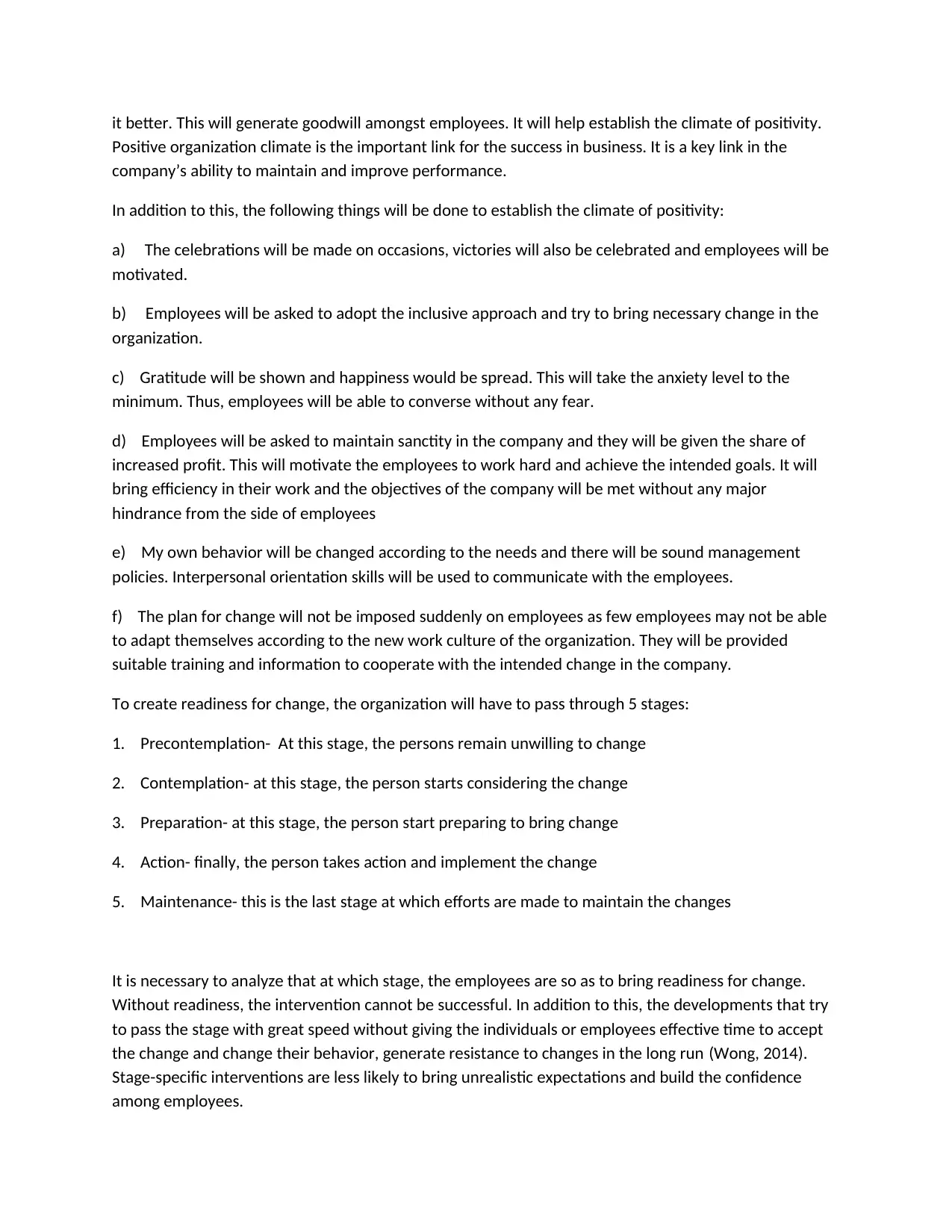
it better. This will generate goodwill amongst employees. It will help establish the climate of positivity.
Positive organization climate is the important link for the success in business. It is a key link in the
company’s ability to maintain and improve performance.
In addition to this, the following things will be done to establish the climate of positivity:
a) The celebrations will be made on occasions, victories will also be celebrated and employees will be
motivated.
b) Employees will be asked to adopt the inclusive approach and try to bring necessary change in the
organization.
c) Gratitude will be shown and happiness would be spread. This will take the anxiety level to the
minimum. Thus, employees will be able to converse without any fear.
d) Employees will be asked to maintain sanctity in the company and they will be given the share of
increased profit. This will motivate the employees to work hard and achieve the intended goals. It will
bring efficiency in their work and the objectives of the company will be met without any major
hindrance from the side of employees
e) My own behavior will be changed according to the needs and there will be sound management
policies. Interpersonal orientation skills will be used to communicate with the employees.
f) The plan for change will not be imposed suddenly on employees as few employees may not be able
to adapt themselves according to the new work culture of the organization. They will be provided
suitable training and information to cooperate with the intended change in the company.
To create readiness for change, the organization will have to pass through 5 stages:
1. Precontemplation- At this stage, the persons remain unwilling to change
2. Contemplation- at this stage, the person starts considering the change
3. Preparation- at this stage, the person start preparing to bring change
4. Action- finally, the person takes action and implement the change
5. Maintenance- this is the last stage at which efforts are made to maintain the changes
It is necessary to analyze that at which stage, the employees are so as to bring readiness for change.
Without readiness, the intervention cannot be successful. In addition to this, the developments that try
to pass the stage with great speed without giving the individuals or employees effective time to accept
the change and change their behavior, generate resistance to changes in the long run (Wong, 2014).
Stage-specific interventions are less likely to bring unrealistic expectations and build the confidence
among employees.
Positive organization climate is the important link for the success in business. It is a key link in the
company’s ability to maintain and improve performance.
In addition to this, the following things will be done to establish the climate of positivity:
a) The celebrations will be made on occasions, victories will also be celebrated and employees will be
motivated.
b) Employees will be asked to adopt the inclusive approach and try to bring necessary change in the
organization.
c) Gratitude will be shown and happiness would be spread. This will take the anxiety level to the
minimum. Thus, employees will be able to converse without any fear.
d) Employees will be asked to maintain sanctity in the company and they will be given the share of
increased profit. This will motivate the employees to work hard and achieve the intended goals. It will
bring efficiency in their work and the objectives of the company will be met without any major
hindrance from the side of employees
e) My own behavior will be changed according to the needs and there will be sound management
policies. Interpersonal orientation skills will be used to communicate with the employees.
f) The plan for change will not be imposed suddenly on employees as few employees may not be able
to adapt themselves according to the new work culture of the organization. They will be provided
suitable training and information to cooperate with the intended change in the company.
To create readiness for change, the organization will have to pass through 5 stages:
1. Precontemplation- At this stage, the persons remain unwilling to change
2. Contemplation- at this stage, the person starts considering the change
3. Preparation- at this stage, the person start preparing to bring change
4. Action- finally, the person takes action and implement the change
5. Maintenance- this is the last stage at which efforts are made to maintain the changes
It is necessary to analyze that at which stage, the employees are so as to bring readiness for change.
Without readiness, the intervention cannot be successful. In addition to this, the developments that try
to pass the stage with great speed without giving the individuals or employees effective time to accept
the change and change their behavior, generate resistance to changes in the long run (Wong, 2014).
Stage-specific interventions are less likely to bring unrealistic expectations and build the confidence
among employees.
⊘ This is a preview!⊘
Do you want full access?
Subscribe today to unlock all pages.

Trusted by 1+ million students worldwide
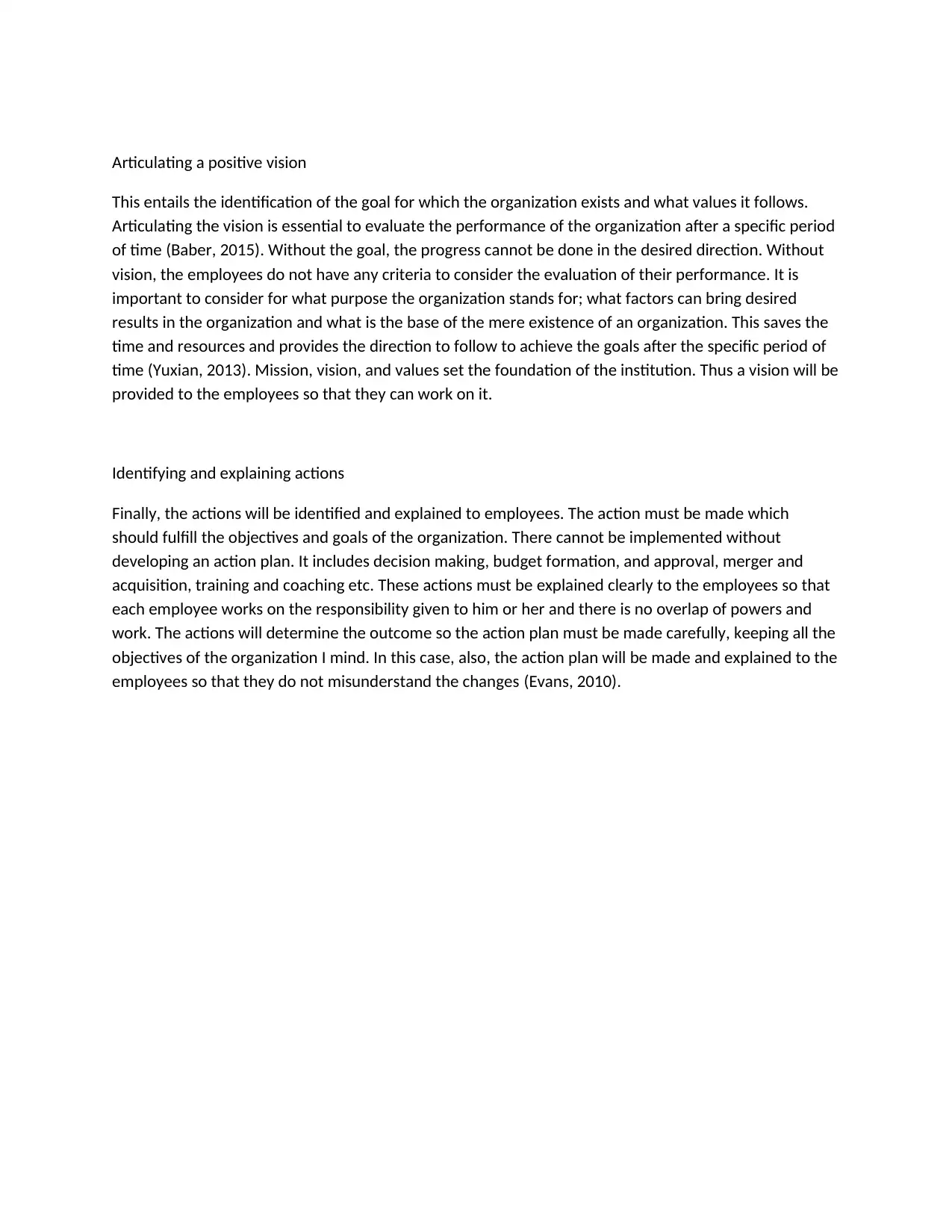
Articulating a positive vision
This entails the identification of the goal for which the organization exists and what values it follows.
Articulating the vision is essential to evaluate the performance of the organization after a specific period
of time (Baber, 2015). Without the goal, the progress cannot be done in the desired direction. Without
vision, the employees do not have any criteria to consider the evaluation of their performance. It is
important to consider for what purpose the organization stands for; what factors can bring desired
results in the organization and what is the base of the mere existence of an organization. This saves the
time and resources and provides the direction to follow to achieve the goals after the specific period of
time (Yuxian, 2013). Mission, vision, and values set the foundation of the institution. Thus a vision will be
provided to the employees so that they can work on it.
Identifying and explaining actions
Finally, the actions will be identified and explained to employees. The action must be made which
should fulfill the objectives and goals of the organization. There cannot be implemented without
developing an action plan. It includes decision making, budget formation, and approval, merger and
acquisition, training and coaching etc. These actions must be explained clearly to the employees so that
each employee works on the responsibility given to him or her and there is no overlap of powers and
work. The actions will determine the outcome so the action plan must be made carefully, keeping all the
objectives of the organization I mind. In this case, also, the action plan will be made and explained to the
employees so that they do not misunderstand the changes (Evans, 2010).
This entails the identification of the goal for which the organization exists and what values it follows.
Articulating the vision is essential to evaluate the performance of the organization after a specific period
of time (Baber, 2015). Without the goal, the progress cannot be done in the desired direction. Without
vision, the employees do not have any criteria to consider the evaluation of their performance. It is
important to consider for what purpose the organization stands for; what factors can bring desired
results in the organization and what is the base of the mere existence of an organization. This saves the
time and resources and provides the direction to follow to achieve the goals after the specific period of
time (Yuxian, 2013). Mission, vision, and values set the foundation of the institution. Thus a vision will be
provided to the employees so that they can work on it.
Identifying and explaining actions
Finally, the actions will be identified and explained to employees. The action must be made which
should fulfill the objectives and goals of the organization. There cannot be implemented without
developing an action plan. It includes decision making, budget formation, and approval, merger and
acquisition, training and coaching etc. These actions must be explained clearly to the employees so that
each employee works on the responsibility given to him or her and there is no overlap of powers and
work. The actions will determine the outcome so the action plan must be made carefully, keeping all the
objectives of the organization I mind. In this case, also, the action plan will be made and explained to the
employees so that they do not misunderstand the changes (Evans, 2010).
Paraphrase This Document
Need a fresh take? Get an instant paraphrase of this document with our AI Paraphraser
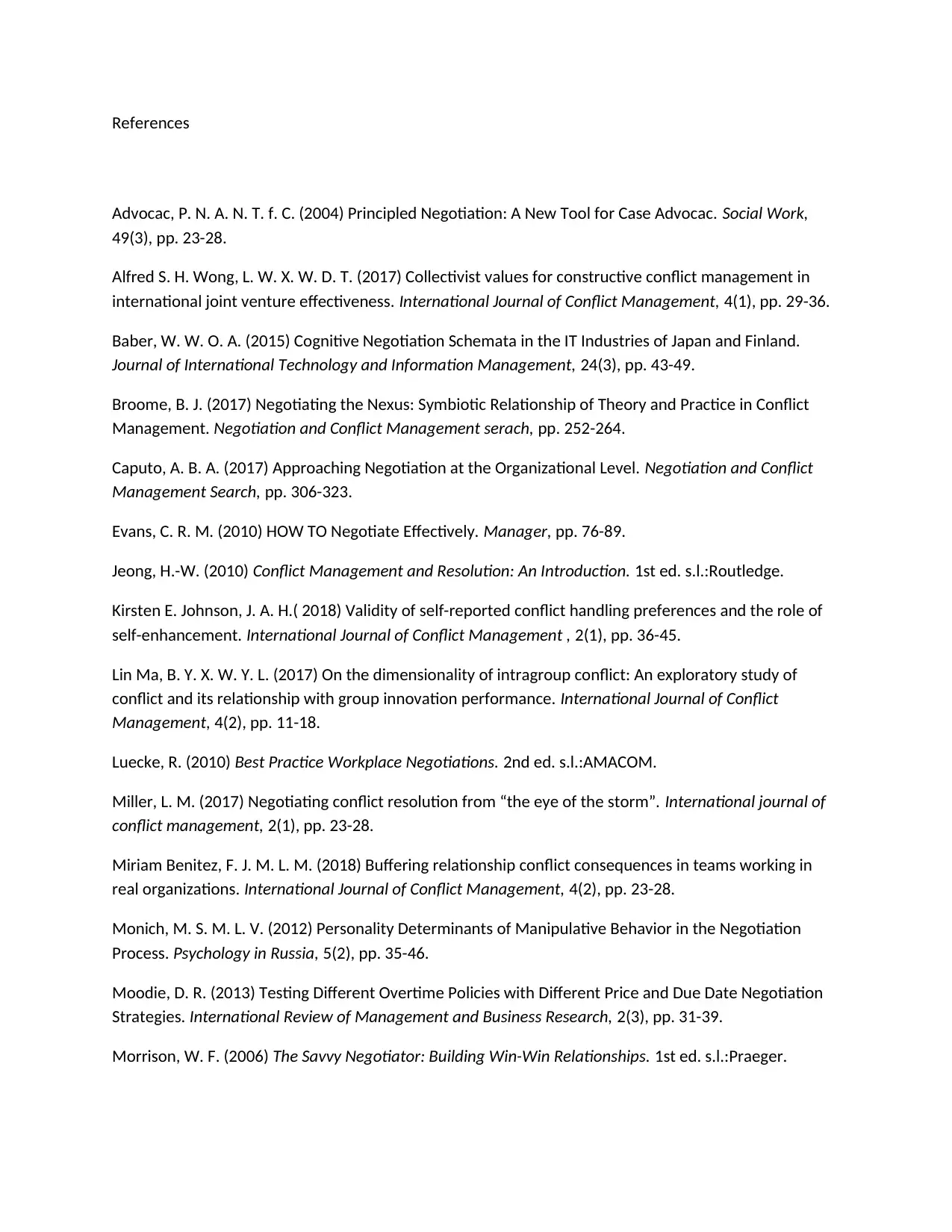
References
Advocac, P. N. A. N. T. f. C. (2004) Principled Negotiation: A New Tool for Case Advocac. Social Work,
49(3), pp. 23-28.
Alfred S. H. Wong, L. W. X. W. D. T. (2017) Collectivist values for constructive conflict management in
international joint venture effectiveness. International Journal of Conflict Management, 4(1), pp. 29-36.
Baber, W. W. O. A. (2015) Cognitive Negotiation Schemata in the IT Industries of Japan and Finland.
Journal of International Technology and Information Management, 24(3), pp. 43-49.
Broome, B. J. (2017) Negotiating the Nexus: Symbiotic Relationship of Theory and Practice in Conflict
Management. Negotiation and Conflict Management serach, pp. 252-264.
Caputo, A. B. A. (2017) Approaching Negotiation at the Organizational Level. Negotiation and Conflict
Management Search, pp. 306-323.
Evans, C. R. M. (2010) HOW TO Negotiate Effectively. Manager, pp. 76-89.
Jeong, H.-W. (2010) Conflict Management and Resolution: An Introduction. 1st ed. s.l.:Routledge.
Kirsten E. Johnson, J. A. H.( 2018) Validity of self-reported conflict handling preferences and the role of
self-enhancement. International Journal of Conflict Management , 2(1), pp. 36-45.
Lin Ma, B. Y. X. W. Y. L. (2017) On the dimensionality of intragroup conflict: An exploratory study of
conflict and its relationship with group innovation performance. International Journal of Conflict
Management, 4(2), pp. 11-18.
Luecke, R. (2010) Best Practice Workplace Negotiations. 2nd ed. s.l.:AMACOM.
Miller, L. M. (2017) Negotiating conflict resolution from “the eye of the storm”. International journal of
conflict management, 2(1), pp. 23-28.
Miriam Benitez, F. J. M. L. M. (2018) Buffering relationship conflict consequences in teams working in
real organizations. International Journal of Conflict Management, 4(2), pp. 23-28.
Monich, M. S. M. L. V. (2012) Personality Determinants of Manipulative Behavior in the Negotiation
Process. Psychology in Russia, 5(2), pp. 35-46.
Moodie, D. R. (2013) Testing Different Overtime Policies with Different Price and Due Date Negotiation
Strategies. International Review of Management and Business Research, 2(3), pp. 31-39.
Morrison, W. F. (2006) The Savvy Negotiator: Building Win-Win Relationships. 1st ed. s.l.:Praeger.
Advocac, P. N. A. N. T. f. C. (2004) Principled Negotiation: A New Tool for Case Advocac. Social Work,
49(3), pp. 23-28.
Alfred S. H. Wong, L. W. X. W. D. T. (2017) Collectivist values for constructive conflict management in
international joint venture effectiveness. International Journal of Conflict Management, 4(1), pp. 29-36.
Baber, W. W. O. A. (2015) Cognitive Negotiation Schemata in the IT Industries of Japan and Finland.
Journal of International Technology and Information Management, 24(3), pp. 43-49.
Broome, B. J. (2017) Negotiating the Nexus: Symbiotic Relationship of Theory and Practice in Conflict
Management. Negotiation and Conflict Management serach, pp. 252-264.
Caputo, A. B. A. (2017) Approaching Negotiation at the Organizational Level. Negotiation and Conflict
Management Search, pp. 306-323.
Evans, C. R. M. (2010) HOW TO Negotiate Effectively. Manager, pp. 76-89.
Jeong, H.-W. (2010) Conflict Management and Resolution: An Introduction. 1st ed. s.l.:Routledge.
Kirsten E. Johnson, J. A. H.( 2018) Validity of self-reported conflict handling preferences and the role of
self-enhancement. International Journal of Conflict Management , 2(1), pp. 36-45.
Lin Ma, B. Y. X. W. Y. L. (2017) On the dimensionality of intragroup conflict: An exploratory study of
conflict and its relationship with group innovation performance. International Journal of Conflict
Management, 4(2), pp. 11-18.
Luecke, R. (2010) Best Practice Workplace Negotiations. 2nd ed. s.l.:AMACOM.
Miller, L. M. (2017) Negotiating conflict resolution from “the eye of the storm”. International journal of
conflict management, 2(1), pp. 23-28.
Miriam Benitez, F. J. M. L. M. (2018) Buffering relationship conflict consequences in teams working in
real organizations. International Journal of Conflict Management, 4(2), pp. 23-28.
Monich, M. S. M. L. V. (2012) Personality Determinants of Manipulative Behavior in the Negotiation
Process. Psychology in Russia, 5(2), pp. 35-46.
Moodie, D. R. (2013) Testing Different Overtime Policies with Different Price and Due Date Negotiation
Strategies. International Review of Management and Business Research, 2(3), pp. 31-39.
Morrison, W. F. (2006) The Savvy Negotiator: Building Win-Win Relationships. 1st ed. s.l.:Praeger.
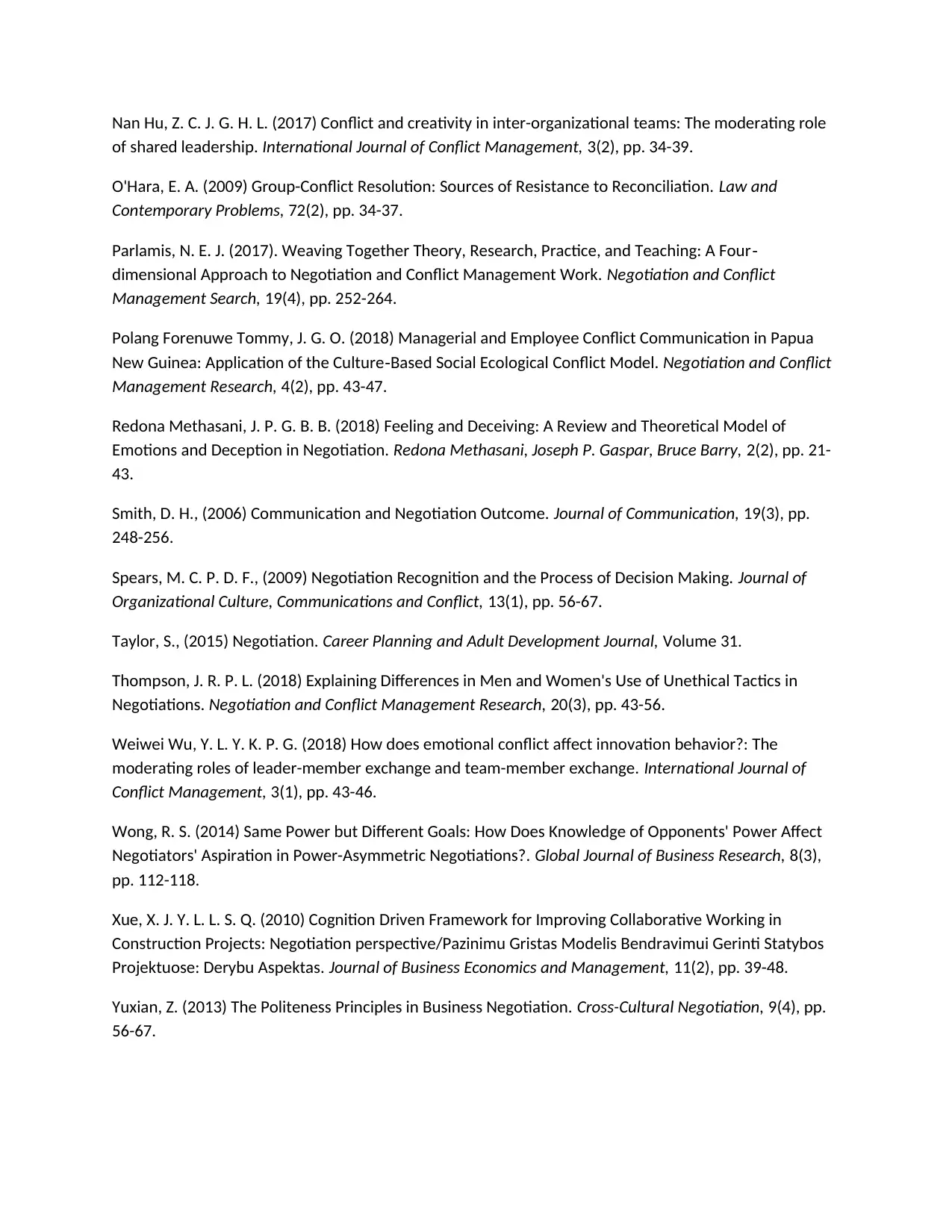
Nan Hu, Z. C. J. G. H. L. (2017) Conflict and creativity in inter-organizational teams: The moderating role
of shared leadership. International Journal of Conflict Management, 3(2), pp. 34-39.
O'Hara, E. A. (2009) Group-Conflict Resolution: Sources of Resistance to Reconciliation. Law and
Contemporary Problems, 72(2), pp. 34-37.
Parlamis, N. E. J. (2017). Weaving Together Theory, Research, Practice, and Teaching: A Four‐
dimensional Approach to Negotiation and Conflict Management Work. Negotiation and Conflict
Management Search, 19(4), pp. 252-264.
Polang Forenuwe Tommy, J. G. O. (2018) Managerial and Employee Conflict Communication in Papua
New Guinea: Application of the Culture‐Based Social Ecological Conflict Model. Negotiation and Conflict
Management Research, 4(2), pp. 43-47.
Redona Methasani, J. P. G. B. B. (2018) Feeling and Deceiving: A Review and Theoretical Model of
Emotions and Deception in Negotiation. Redona Methasani, Joseph P. Gaspar, Bruce Barry, 2(2), pp. 21-
43.
Smith, D. H., (2006) Communication and Negotiation Outcome. Journal of Communication, 19(3), pp.
248-256.
Spears, M. C. P. D. F., (2009) Negotiation Recognition and the Process of Decision Making. Journal of
Organizational Culture, Communications and Conflict, 13(1), pp. 56-67.
Taylor, S., (2015) Negotiation. Career Planning and Adult Development Journal, Volume 31.
Thompson, J. R. P. L. (2018) Explaining Differences in Men and Women's Use of Unethical Tactics in
Negotiations. Negotiation and Conflict Management Research, 20(3), pp. 43-56.
Weiwei Wu, Y. L. Y. K. P. G. (2018) How does emotional conflict affect innovation behavior?: The
moderating roles of leader-member exchange and team-member exchange. International Journal of
Conflict Management, 3(1), pp. 43-46.
Wong, R. S. (2014) Same Power but Different Goals: How Does Knowledge of Opponents' Power Affect
Negotiators' Aspiration in Power-Asymmetric Negotiations?. Global Journal of Business Research, 8(3),
pp. 112-118.
Xue, X. J. Y. L. L. S. Q. (2010) Cognition Driven Framework for Improving Collaborative Working in
Construction Projects: Negotiation perspective/Pazinimu Gristas Modelis Bendravimui Gerinti Statybos
Projektuose: Derybu Aspektas. Journal of Business Economics and Management, 11(2), pp. 39-48.
Yuxian, Z. (2013) The Politeness Principles in Business Negotiation. Cross-Cultural Negotiation, 9(4), pp.
56-67.
of shared leadership. International Journal of Conflict Management, 3(2), pp. 34-39.
O'Hara, E. A. (2009) Group-Conflict Resolution: Sources of Resistance to Reconciliation. Law and
Contemporary Problems, 72(2), pp. 34-37.
Parlamis, N. E. J. (2017). Weaving Together Theory, Research, Practice, and Teaching: A Four‐
dimensional Approach to Negotiation and Conflict Management Work. Negotiation and Conflict
Management Search, 19(4), pp. 252-264.
Polang Forenuwe Tommy, J. G. O. (2018) Managerial and Employee Conflict Communication in Papua
New Guinea: Application of the Culture‐Based Social Ecological Conflict Model. Negotiation and Conflict
Management Research, 4(2), pp. 43-47.
Redona Methasani, J. P. G. B. B. (2018) Feeling and Deceiving: A Review and Theoretical Model of
Emotions and Deception in Negotiation. Redona Methasani, Joseph P. Gaspar, Bruce Barry, 2(2), pp. 21-
43.
Smith, D. H., (2006) Communication and Negotiation Outcome. Journal of Communication, 19(3), pp.
248-256.
Spears, M. C. P. D. F., (2009) Negotiation Recognition and the Process of Decision Making. Journal of
Organizational Culture, Communications and Conflict, 13(1), pp. 56-67.
Taylor, S., (2015) Negotiation. Career Planning and Adult Development Journal, Volume 31.
Thompson, J. R. P. L. (2018) Explaining Differences in Men and Women's Use of Unethical Tactics in
Negotiations. Negotiation and Conflict Management Research, 20(3), pp. 43-56.
Weiwei Wu, Y. L. Y. K. P. G. (2018) How does emotional conflict affect innovation behavior?: The
moderating roles of leader-member exchange and team-member exchange. International Journal of
Conflict Management, 3(1), pp. 43-46.
Wong, R. S. (2014) Same Power but Different Goals: How Does Knowledge of Opponents' Power Affect
Negotiators' Aspiration in Power-Asymmetric Negotiations?. Global Journal of Business Research, 8(3),
pp. 112-118.
Xue, X. J. Y. L. L. S. Q. (2010) Cognition Driven Framework for Improving Collaborative Working in
Construction Projects: Negotiation perspective/Pazinimu Gristas Modelis Bendravimui Gerinti Statybos
Projektuose: Derybu Aspektas. Journal of Business Economics and Management, 11(2), pp. 39-48.
Yuxian, Z. (2013) The Politeness Principles in Business Negotiation. Cross-Cultural Negotiation, 9(4), pp.
56-67.
⊘ This is a preview!⊘
Do you want full access?
Subscribe today to unlock all pages.

Trusted by 1+ million students worldwide

1 out of 10
Related Documents
Your All-in-One AI-Powered Toolkit for Academic Success.
+13062052269
info@desklib.com
Available 24*7 on WhatsApp / Email
![[object Object]](/_next/static/media/star-bottom.7253800d.svg)
Unlock your academic potential
Copyright © 2020–2025 A2Z Services. All Rights Reserved. Developed and managed by ZUCOL.





